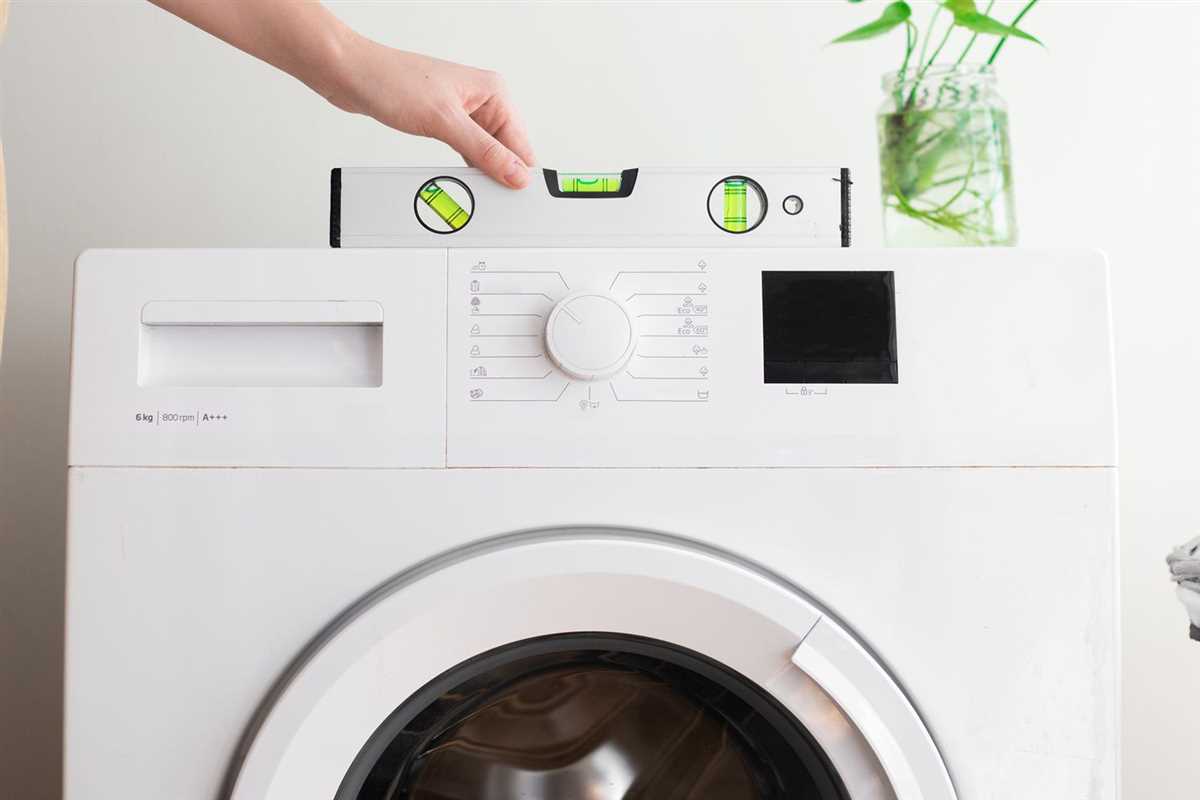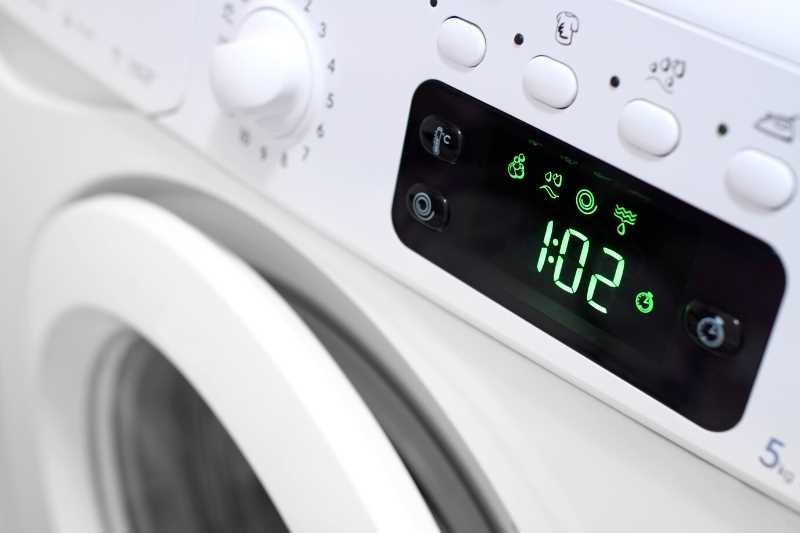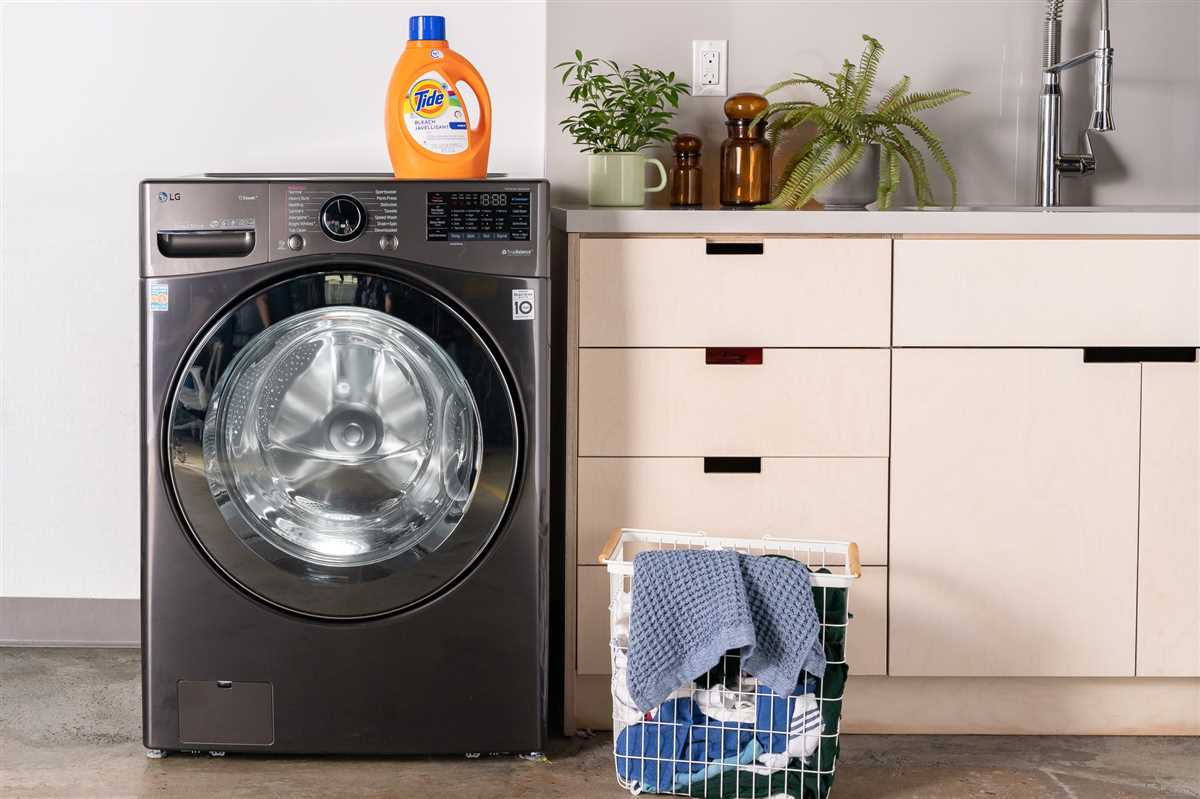




Have you ever set your washing machine to a specific cycle, only to find that the remaining time displayed was nowhere near accurate? Many of us have experienced this puzzling phenomenon, and it begs the question: why do washing machines mislead about the remaining time?
One reason for this deception is the complex nature of the washing process. The time estimation displayed on your machine is based on a predetermined algorithm that takes into account factors such as the load size, fabric type, and desired level of cleanliness. However, these calculations are not always precise, and unexpected variables can cause the remaining time to fluctuate.
Another factor to consider is the marketing strategy employed by manufacturers. Washing machines with shorter cycle times are often viewed as more efficient and appealing to consumers. To meet these expectations, manufacturers may program their machines to display shorter remaining times, even if the actual duration is longer. This tactic is used to create the perception of a faster and more efficient machine, ultimately driving sales.
Additionally, the variability in water pressure and temperature can impact the duration of the wash cycle. If the machine senses that the water pressure or temperature is not optimal, it may adjust the remaining time accordingly. This fluctuation in time can be frustrating for users who rely on the displayed remaining time to plan their day.
In conclusion, the misleading remaining time displayed by washing machines can be attributed to a combination of factors including the complexity of the washing process, marketing strategies employed by manufacturers, and variability in water pressure and temperature. While it may be frustrating, understanding these factors can help us make more informed decisions when it comes to choosing and using our washing machines.
The Hidden Truth: Misleading Washing Machine Timers Exposed
Have you ever wondered why the remaining time displayed on your washing machine seems to stretch on forever? Well, you’re not alone. Many people have noticed the discrepancy between the projected time and the actual time it takes to complete a washing cycle. In this article, we debunk the mystery behind washing machine timers and expose the hidden truth.
The Psychology Behind Misleading Timers
One of the main reasons why washing machine timers are often inaccurate is due to the psychological effects it has on consumers. By displaying a shorter time, manufacturers create the perception that the machine is more efficient and saves time. This instills a sense of trust and satisfaction in the consumer, leading them to choose that particular brand or model over others.
Additionally, a shorter displayed time may encourage users to select a more expensive and energy-intensive wash option, such as a quick wash or high-temperature setting. This ultimately increases the consumption of resources, benefiting both the manufacturer and utility companies.
The Technical Explanation

Another factor contributing to the discrepancy is the complexity of modern washing machines. These devices are equipped with sensors and algorithms that monitor and adjust various factors such as temperature, water level, and agitation speed. These adjustments are made throughout the cycle to optimize washing performance and reduce damage to clothes.
While these technological advancements improve the quality of the wash, they can also cause variations in the cycle time. The machine may need to pause or repeat certain cycles to ensure thorough cleaning. However, these additional steps are not always accounted for in the projected time displayed on the machine, leading to misleading estimates.
The Manufacturer’s Motive
Manufacturers have a vested interest in misleading consumers about the remaining time. By displaying a shorter time, they create an illusion of efficiency that appeals to buyers. This tactic helps to boost sales and maintain customer satisfaction, even if it comes at the expense of accuracy.
Additionally, shorter projected times make it easier for manufacturers to comply with industry standards and regulations. By manipulating the displayed time, they can meet requirements without actually improving the efficiency or effectiveness of the washing machine.
Conclusion


While washing machine timers may be misleading, understanding the psychology and technical aspects behind them can help consumers make more informed decisions. It’s important to consider the actual performance of the machine and not solely rely on the displayed time. By debunking the mystery and exposing the hidden truth, we can navigate the world of washing machines with a clearer understanding.
The Illusion of Precision: Understanding Washing Machine Timers

Have you ever noticed that the remaining time displayed on your washing machine seems to be in constant flux? One minute it says there are 30 minutes left, and the next it jumps to 20. This can be frustrating, especially if you’re trying to plan your day around when your laundry will be completed. However, this phenomenon is not unique to your washing machine; it’s a common issue that many users face.
At first glance, you might think that the manufacturer of your washing machine is deliberately misleading you with inaccurate timers. However, the reality is far more nuanced. Understanding how washing machine timers work can shed some light on why they seem to be so imprecise.
1. Estimations, not Exact Timings
When your washing machine displays the remaining time, it is not providing an exact calculation of how much time is left in the cycle. Instead, it is making an educated estimation based on the program you have selected, the load size, and other factors. It takes into account the duration of each cycle stage, such as washing, rinsing, and spinning, and calculates the total time accordingly.
2. Adaptability to Changes
Your washing machine’s timer is designed to be adaptable to unexpected changes during the cycle. For example, if it detects that the load is heavier or dirtier than anticipated, it may adjust the duration of the wash or rinse cycles to ensure proper cleaning. These adjustments can result in the displayed time changing as the machine responds to the conditions it encounters.
3. Sensing Mechanisms

Washing machines are equipped with various sensors to monitor factors like water level, temperature, and dirtiness of the load. These sensors help the machine determine the appropriate cycle duration and make any necessary adjustments. The frequent updates from these sensors can cause the displayed time to fluctuate as the machine gathers more data during the cycle.
4. User Expectations
Manufacturers understand that users tend to prefer shorter cycle times, as they perceive them to be more efficient. To meet these expectations, washing machine timers often provide slightly optimistic estimates. This way, users may be pleasantly surprised when their laundry is finished earlier than anticipated.
Conclusion
While the constantly changing remaining time on washing machine timers can be frustrating, it is not indicative of a malfunction or deliberate misrepresentation by the manufacturer. Understanding the factors that contribute to this phenomenon can help to alleviate some of the frustrations and allow you to plan your day more effectively around your laundry cycles.
Psychological Manipulation: How Misleading Time Estimates Affect Consumers
When it comes to household appliances, washing machines are a staple in most homes. They provide a convenient way to clean our clothes, but have you ever noticed that the time estimates they display can be misleading? This is not a coincidence, but rather a deliberate psychological manipulation used by manufacturers to influence consumer behavior.
Understanding the Manipulation Tactics
Washing machines often display an estimated time remaining for the cycle to complete. However, this time estimate is rarely accurate and can fluctuate significantly throughout the cycle. This inconsistency creates a sense of uncertainty and frustration for consumers, causing them to grow impatient and actively seek alternatives.
Manufacturers intentionally design washing machines to display longer time estimates to make consumers believe that their appliances are more efficient and performing a thorough cleaning. This psychological trickery drives consumers to choose these machines over others, as longer time estimates are associated with superior performance and quality.
The Impact on Consumer Behavior
Consumers who are misled by these time estimates may be more likely to make impulsive decisions, such as purchasing a more expensive washing machine with features they may not necessarily need. They may also be more willing to invest in additional laundry products or services that promise to expedite the process and save time.
Moreover, the inaccurate time estimates can lead to frustration and disappointment when the cycle takes longer than expected. This negative experience can have long-lasting effects on consumer satisfaction, potentially influencing their future purchasing decisions and brand loyalty.
The Need for Transparency
As consumers become more aware of these psychological manipulation tactics, there has been a growing demand for transparency in the information provided by manufacturers. Consumers want to make informed decisions based on accurate and reliable data.
Manufacturers should strive to provide more realistic time estimates for washing machine cycles. Clear and honest communication with consumers can help build trust and maintain a positive relationship. Additionally, technological advancements can be made to improve the accuracy of these estimates, ensuring a more seamless and satisfying user experience.
Conclusion
The misleading time estimates displayed by washing machines are not mere coincidences, but calculated psychological manipulations meant to influence consumer behavior. Understanding these tactics can empower consumers to make informed choices and demand transparency from manufacturers. By doing so, we can strive for a more honest and trustworthy marketplace.
Technical Limitations: The Challenges of Estimating Remaining Washing Time
In the world of modern washing machines, one mystery that baffles many users is why the estimated remaining time displayed on the machine often seems inaccurate. This discrepancy between the displayed time and the actual time it takes for a cycle to complete can be frustrating for users who want to plan their day around doing laundry. However, this confusion is not intentional but rather a result of the technical limitations inherent in the design of washing machines.
Complexity of Washing Cycles
One of the key challenges in estimating remaining washing time is the complexity of washing cycles themselves. Washing machines are designed to offer different cycles depending on the specific needs of the laundry being cleaned. Each cycle may involve various stages such as soaking, spinning, rinsing, and drying, each with its own time requirements. Determining the exact time it will take for each stage can be difficult due to factors such as the size and type of load, water temperature, and detergent used.
Variability in Load Conditions
Another factor that contributes to the inaccurate estimation of remaining washing time is the variability in load conditions. Users may load their machines with different amounts and types of laundry, which can affect the overall time it takes to complete a cycle. For example, a machine loaded with only a few lightweight garments will likely complete its cycle faster than one loaded with a full load of heavy blankets. The variability in load conditions makes it challenging for washing machines to provide an accurate estimation of remaining time.
Inability to Account for Individual User Preferences
Furthermore, washing machines lack the capability to account for individual user preferences. Some users may prefer a longer cycle for heavily soiled garments, while others may opt for a shorter cycle for lightly soiled items. Additionally, users may pause or modify cycles midway, further complicating the estimation of remaining time. Since the preferences and actions of users cannot be predicted or accounted for, it is challenging for washing machines to accurately estimate how much time is left before a cycle completes.
Manufacturer’s Safety Buffer
Lastly, the manufacturers of washing machines often include a safety buffer in the displayed remaining time as a precautionary measure. This buffer accounts for any unexpected delays or issues that may arise during the cycle, such as water temperature adjustments, unbalanced loads, or power fluctuations. While this safety buffer ensures that the cycle completes successfully, it adds to the discrepancy between the estimated and actual remaining time.
In conclusion, the estimation of remaining washing time is a challenging task for washing machines due to the complexity of washing cycles, variability in load conditions, the inability to account for individual user preferences, and the inclusion of safety buffers by manufacturers. While manufacturers are continuously working to improve the accuracy of these estimates, users should be aware that the displayed remaining time is an estimate and may not always align with the actual time it takes for a cycle to complete.
Marketing Tactics: The Role of Misleading Time Estimates in Product Promotion
In the highly competitive world of consumer products, effective marketing tactics play a crucial role in influencing consumer behavior and driving sales. One such tactic is the use of misleading time estimates in product promotion, particularly in the case of washing machines. This strategy aims to create a sense of urgency and exclusivity, ultimately persuading consumers to make a purchase decision.
The Power of Limited Time
Companies often employ the strategy of presenting time-limited offers as a way to enhance the desirability of their products. By displaying a countdown or a specific time frame, they create an illusion of scarcity, prompting consumers to act quickly for fear of missing out. Washing machines manufacturers apply this tactic by providing estimated cycle times that are shorter than the actual duration, instilling a sense of convenience and efficiency.
This marketing strategy leverages the basic human desire to save time and effort. By offering a shorter time estimate, manufacturers create the perception that their washing machines are more efficient and time-saving compared to competitors’ models. Consumers are more likely to purchase a product they believe will help streamline their daily routines, even if the perceived time savings are relatively small.
Managing Consumer Expectations

Misleading time estimates can also be seen as a way to manage consumer expectations. Washing machine cycles often vary based on the type and amount of laundry, water temperature, and other factors. By presenting shorter cycle times, manufacturers can prevent potential complaints or disappointment from consumers who may find the actual cycle durations longer than expected. While this tactic may feel deceptive, it is a widely used strategy across various industries to avoid customer dissatisfaction.
Moreover, misleading time estimates also aid in reducing the perceived waiting time. People tend to perceive time as passing more quickly when they are engaged or occupied. By providing lower time estimates, washing machine manufacturers effectively keep consumers occupied with other tasks or activities, making them less aware of the time spent waiting. This psychological phenomenon helps create a positive and satisfactory user experience.
The Need for Transparency
While the use of misleading time estimates may serve marketing purposes, it is important for companies to strike a balance and maintain transparency with their consumers. Ethical marketing practices entail providing accurate information and setting realistic expectations. Creating trust with consumers is crucial for building long-term relationships and fostering brand loyalty.
To mitigate potential concerns associated with misleading time estimates, washing machine manufacturers can adopt alternative marketing tactics. For example, they can use prominently displayed disclaimers indicating that the advertised time estimates are approximations and may vary depending on specific conditions. By doing so, companies demonstrate transparency and allow consumers to make informed purchase decisions.
In conclusion, the use of misleading time estimates in product promotion, such as in the case of washing machines, is a marketing tactic aimed at influencing consumer behavior. While it may create a sense of urgency and convenience, companies should prioritize transparency and provide accurate information to build trust and maintain customer satisfaction.
Consumer Empowerment: How to Make Informed Decisions Despite Misleading Timers
Washing machine timers have long been a subject of frustration for consumers. Many washing machines display an estimated time remaining for a cycle, but these timers are often inaccurate and misleading. However, there are ways consumers can make informed decisions and overcome the challenge of misleading timers.
1. Understand the Nature of the Timer
It’s important to recognize that the timer on a washing machine is an estimate and not an exact measurement of the time remaining for a cycle. Various factors can influence the actual duration, such as the size of the load, water temperature, detergent type, and machine efficiency. Keeping this in mind will help you set realistic expectations and avoid disappointment.
2. Use Manufacturer’s Recommendations
Manufacturers often provide guidelines on cycle durations for different types of loads. It’s a good idea to refer to these recommendations when estimating the time required for a specific cycle. While the actual time may still differ, following the manufacturer’s advice will give you a better idea of what to expect.
3. Observe the Cycle Progress
Instead of solely relying on the timer, monitor the progress of the washing machine cycle. Many models have indicators or LEDs that show the stage of the process, such as washing, rinsing, or spinning. By observing the cycle and understanding the different stages, you can get a more accurate sense of when the cycle is nearing completion.
4. Don’t Rush and Plan Ahead

Misleading timers can be frustrating, but it’s important not to rush through the cycle. Instead, plan ahead and start the laundry with enough time to spare. By allowing extra time, you won’t be stressed or disappointed if the cycle takes longer than indicated. Planning ahead will also help you prioritize your laundry tasks accordingly.
5. Focus on Efficiency and Features
While the timer may not be reliable, you can still make informed decisions when choosing a washing machine based on its efficiency and features. Look for machines that offer energy-saving options, quick wash cycles, and customizable settings. These features will enhance your control over the laundry process and minimize the impact of inaccurate timers.
Conclusion
Although misleading washing machine timers can be frustrating, consumers can still make informed decisions and overcome this challenge. By understanding the nature of the timer, using manufacturer’s recommendations, observing the cycle progress, planning ahead, and focusing on efficiency and features, consumers can empower themselves to make the best decisions for their laundry needs.
FAQ
Why do washing machines always seem to take longer than they originally say?
Washing machines often mislead about the remaining time due to a variety of factors. One reason is that the estimated time displayed does not account for various settings and options the user may have selected. Additionally, the machine may adjust the time based on the weight and type of load, so the actual time can vary. Furthermore, the machine may pause periodically to balance the load or ensure proper water levels, which can also add to the total time.
Is there a way to know the exact remaining time left on a washing cycle?
Unfortunately, it is difficult to know the exact remaining time left on a washing cycle. The displayed time is only an estimate and can be influenced by several factors such as load size, type of fabric, selected settings, and any interruptions or pauses the machine may make for various reasons. It is best to plan your tasks accordingly and allow for some flexibility in your schedule when doing laundry.
Why do washing machines mislead about the remaining time, instead of providing an accurate estimate?
Washing machines mislead about the remaining time primarily because providing an accurate estimate is challenging. The machines need to factor in various variables such as load size, fabric type, selected settings, and any necessary pauses or adjustments for optimal performance. Achieving a completely accurate estimate in real-time can be difficult due to these variables, which is why the displayed time is often only an estimation.
Can I speed up the washing cycle to make it finish faster?
While it may be tempting to speed up the washing cycle to finish faster, it is not recommended. Washing cycles are designed to ensure proper cleaning and care for your clothes. Altering the cycle time can negatively impact the cleaning quality and may not fully remove dirt, stains, or odors. It is best to follow the recommended cycle durations to ensure the best results and prolong the lifespan of your garments.
Why is it important to have flexible expectations when it comes to the remaining time on a washing machine?
It is essential to have flexible expectations regarding the remaining time on a washing machine because the displayed time is an estimate and can vary based on several factors. Understanding that the machine may need to make adjustments, balance the load, or pause intermittently allows you to plan your tasks accordingly. Having flexible expectations helps avoid frustration or disappointment if the cycle takes longer than initially displayed.
Why do washing machines often display the wrong remaining time?
Washing machines often display the wrong remaining time due to the complex algorithms they use to calculate the time remaining for a particular cycle. These algorithms take into account various factors such as the weight and type of the load, water temperature, and cycle selected. However, as the machines cannot accurately predict when certain stages of the cycle will be completed, the remaining time displayed may not always be accurate.
Is there any way to make a washing machine show the correct remaining time?
While it is difficult to make a washing machine always show the correct remaining time, there are a few things you can do to help improve accuracy. First, make sure to load the machine correctly and don’t overload it, as this can affect the machine’s ability to accurately estimate the time remaining. Additionally, try to use the same type of load and cycle settings regularly, as this will help the machine learn and provide more accurate estimates over time. It’s important to remember, however, that due to the nature of laundry cycles, the remaining time will never be 100% precise.













